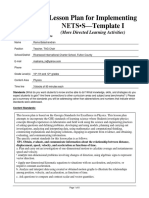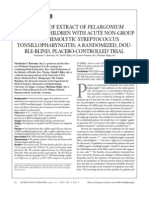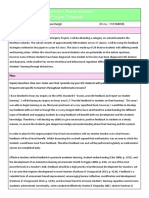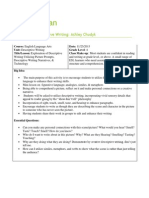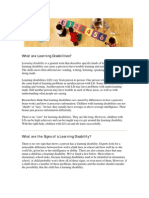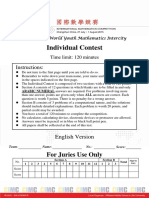Vision Impairment Teaching Strategies
Vision Impairment Teaching Strategies
Uploaded by
KatrinaCopyright:
Available Formats
Vision Impairment Teaching Strategies
Vision Impairment Teaching Strategies
Uploaded by
KatrinaCopyright
Available Formats
Share this document
Did you find this document useful?
Is this content inappropriate?
Copyright:
Available Formats
Vision Impairment Teaching Strategies
Vision Impairment Teaching Strategies
Uploaded by
KatrinaCopyright:
Available Formats
STRATEGIES FOR TEACHING STUDENTS WITH VISION
IMPAIRMENTS
Introduction
There are two main functional categories of visual impairments: Low Vision and
Blind. Low vision students usually are print users, but may require special equipment and
materials. The definition of legal blindness covers a broad spectrum of visual impairments.
The extent of visual disability depends upon the physical sensory impairment of the
student's eyes, the age of the student at the onset of vision impairment, and the way in
which that impairment occurred. Vision also may fluctuate or may b e influenced by
factors such as inappropriate lighting, light glare, or fatigue. Hence, there is no "typical"
vision impaired student. The major challenge facing visually impaired students in the
science educational environment is the overwhelming mass o f visual material to which
they are continually exposed viz., textbooks, class outlines, class schedules, chalkboards
writing, etc. In addition, the increase in the use of films, videotapes, computers, laser
disks, and television adds to the volume of v visual material to which they have only
limited access. To assist in overcoming a students' visual limitation requires unique and
individual strategies based on that student's particular visual impairment and his/her
skill of communication (e.g., Braille, speed listening, etc.). (After: "The Mainstream
Teaching of Science: A Source Book", Keller et al.)
General Courtesy
Speak to the class upon entering and leaving the room or site.
Call the student with a visual impairment by name if you want his/her attention.
Seat the student away from glaring lights (e.g. by the window) and preferably in
front of the class.
Use descriptive words such as straight, forward, left, etc. in relation to the student's
body orientation. Be specific in directions and avoid the use of vague terms with
unusable information, such as "over there", "here", "this", etc.
Describe, in detail, pertinent visual occurrences of the learning activities.
Describe and tactually familiarize the student to the classroom, laboratory,
equipment, supplies, materials, field sites, etc.
Give verbal notice of room changes, special meetings, or assignments.
Offer to read written information for a person with a visual impairment, when
appropriate.
1
Order the appropriate text books for the students in their preferred medium.
Identify yourself by name; don't assume that the student who is visually impaired
will recognize you by your voice even though you have met before.
If you are asked to guide a student with a visual impairment, identify yourself, offer
your services and, if accepted, offer your arm to the student's hand. Tell them if
they have to step up or step down, let them know if the door is to their left or right,
and warn them of possible hazards.
Orally, let the student know if you need to move or leave or need to end a
conversation.
If a student with a visual impairment is in class, routinely check the instructional
environment to be sure it is adequate and ready for use.
When communicating with a student who has a visual impairment, always identify
yourself and others who are present.
Do not pet or touch a guide dog. Guide dogs are working animals. It can be
hazardous for the visually impaired person if the dog is distracted.
Be understanding of the slight noise made by a portable translator.
Also use an auditory or tactile signal where a visual signal is normally used.
It is not necessary to speak loudly to people with visual impairments.
Always notify changes of class schedule in advance.
Teacher Presentation
By verbally spelling out a new or technical word, you will be helping the student
with a visual impairment, as well as for other students.
An enlarged activity script, directions, or readings of a detailed lesson can be used
for a low vision person and for use in describing tactile 3D models .
Use an overhead projector to show step-by-step instructions. Mask all the
instructions except the one(s) that you want to present.
Use an opaque projector whenever possible to enlarge a text or manual.
All colored objects used for identification related to a lesson, experiment, or other
directions should be labeled with a Braille label maker or otherwise tacitly coded for
most students with vision impairments.
Describe, in detail, visual occurrences, visual media, and directions including all
pertinent aspects that involve sight.
Use a sighted narrator or descriptive video (preferably the latter) to describe
aspects of videos or laser disks.
Describe, in detail, all pertinent visual occurrences or chalkboard writing.
Where needed, have lesson or direction materials Brailed, use an enlarged activity
script, or recorded ahead of time, for class handouts.
Have tactile 3D models, raised line drawings, or thermoforms available to
supplement drawings or graphics in a tactile format when needed.
Whenever possible, use actual objects for three dimensional representations.
Modify instructions for auditory/tactile presentation.
Use raised line drawings for temporary tactile presentations.
Use an overhead projector, chalkboard, graphs, or slides as you would normally, but
provide more detailed oral descriptions, possibly supplemented with thermoforms
where appropriate.
Allow student to use a tape recorder for recording classroom presentations or the
text.
Make all handouts and assignments available in an appropriate form: e.g., regular
print, large print, Braille, or on a cassette, depending on the students optimal mode
of communication.
Use a monocular or a private eye (electronic miniature television) or similar devices
for long range observations of chalk board or demonstration table presentations.
Text Reading Systems
Paid or volunteer readers or writers can assist a student with a visual impairment
with texts, materials, and library readings.
Offer to read, or arrange to have read, written information for a person with a
visual impairment, when appropriate.
Arrange, ahead of time, for audio book acquisition of the text or other reading
materials through the Talking Book Service, Recordings for the Blind and Dyslexic,
text reading systems, or audio output devices.
Various Braille devices can be used to assists vision impaired students when
reading.
Testing
Make arrangements for tactile examinations, if touch is not normally permitted
(say, in a museum) then contact the curator for tactile access to a museum display
items or say, in a zoo for access to a plant/animal species and/or collection).
Place the student being tested close to the activity if tactile examination is
necessary.
Present examinations in a form that will be unbiased to visually impaired students.
Ask the student for the approach he/she finds to be most accessible.
One possible accessible method is to record test questions on tape and have the
students record their answers on tape in an area which has minimal disturbance for
other students.
Use an enlarged activity script, directions, or readings to go along with the testing
material.
Allow more time.
Allow calculators to be used during the test.
Make use of larger print (e.g. 14 pt; 20 pt sized or as needed).
Make use of visual magnification (magnifier or magnifying machine), audiocassette,
Braille/Braille graphs/Braille device for written responses, large block answer sheet.
This information is taken from the following website:
http://www.as.wvu.edu/~scidis/vision.html#sect2
You might also like
- Learn Go With Pocket-Sized ProjectsDocument487 pagesLearn Go With Pocket-Sized Projectslamgiaovien2k10% (1)
- EUO NRSG263 FinalDocument17 pagesEUO NRSG263 FinalJosh TuibeoNo ratings yet
- Abigail Arnold ResumeDocument1 pageAbigail Arnold Resumeapi-525384516No ratings yet
- Informal AssessmentDocument18 pagesInformal AssessmentMohd AminuddinNo ratings yet
- James Waller Pme 832 - Theory in Practice AssignmentDocument6 pagesJames Waller Pme 832 - Theory in Practice Assignmentapi-450537948No ratings yet
- Where Is Sam Fun Activities VideoDocument1 pageWhere Is Sam Fun Activities VideoKilver Silvester100% (1)
- Supporting Children With EBSD Feb 2010Document14 pagesSupporting Children With EBSD Feb 2010Floares MagdaNo ratings yet
- Senior Project PresentationDocument13 pagesSenior Project Presentationapi-535239899No ratings yet
- Evidence-Based Instructional PracticesDocument7 pagesEvidence-Based Instructional Practicesapi-525863960No ratings yet
- Lesson Plan For Implementing NETS - S-Template I: (More Directed Learning Activities)Document8 pagesLesson Plan For Implementing NETS - S-Template I: (More Directed Learning Activities)api-405567093No ratings yet
- Section Three WeeblyDocument127 pagesSection Three Weeblyapi-520295048No ratings yet
- Inclusion IntroductionDocument5 pagesInclusion IntroductionrahmatNo ratings yet
- 27-05-2014548inclusive Educatiion, Key Role of Teacher A2a PDFDocument8 pages27-05-2014548inclusive Educatiion, Key Role of Teacher A2a PDFAngelika PerezNo ratings yet
- Attitudes of Teachers Towards The Inclusion of Children With Special Needs in Primary and Secondary SchoolsDocument15 pagesAttitudes of Teachers Towards The Inclusion of Children With Special Needs in Primary and Secondary SchoolsHrvoje KovačNo ratings yet
- EDU30006-A1-Humanities Portfolio-Maddison Edebohls-102906427Document11 pagesEDU30006-A1-Humanities Portfolio-Maddison Edebohls-102906427Maddie EdebohlsNo ratings yet
- EDST261 Assignment Task 2Document9 pagesEDST261 Assignment Task 2api-512557883No ratings yet
- Lesson Sequence ScienceDocument5 pagesLesson Sequence Scienceapi-349557774No ratings yet
- Edug 808 Unit Plan-FinalDocument26 pagesEdug 808 Unit Plan-Finalapi-273543630No ratings yet
- Efficacy of Extract of Pelargonium Sidoides in Children With Acute Non-Group A Beta-Hemolytic Streptococcus Tonsillopharyngitis: A Randomized, Double-Blind, Placebo-Controlled TrialDocument11 pagesEfficacy of Extract of Pelargonium Sidoides in Children With Acute Non-Group A Beta-Hemolytic Streptococcus Tonsillopharyngitis: A Randomized, Double-Blind, Placebo-Controlled TrialInnoVision Health Media100% (1)
- Assignment 2 AutosavedDocument12 pagesAssignment 2 Autosavedapi-435781463No ratings yet
- Professional Inquiry Project ProposalDocument8 pagesProfessional Inquiry Project Proposalapi-427319867No ratings yet
- Policy For Special Educators in Himachal Pradesh Drafted by Vijay HeerDocument25 pagesPolicy For Special Educators in Himachal Pradesh Drafted by Vijay HeerVIJAY KUMAR HEER100% (1)
- Inclusive Assignment 2Document12 pagesInclusive Assignment 2api-435738355No ratings yet
- Gifted UnderachievementDocument4 pagesGifted Underachievementapi-238729229100% (1)
- Assignment 1 Inclusive Education Callum LoftsDocument14 pagesAssignment 1 Inclusive Education Callum Loftsapi-428973958No ratings yet
- Short Paper 3Document4 pagesShort Paper 3api-519072243No ratings yet
- Edu 317 Multiple Intelligence Theory DefinedDocument5 pagesEdu 317 Multiple Intelligence Theory Definedapi-266890952No ratings yet
- Assignment OneDocument45 pagesAssignment Oneapi-355627407No ratings yet
- 2015 Year One Term 2 Excursion To The MuseumDocument6 pages2015 Year One Term 2 Excursion To The Museumapi-303109188No ratings yet
- INTERVIEW REPORT FinalDocument5 pagesINTERVIEW REPORT Finalfatimah azzahraNo ratings yet
- My Philosophy On Teaching Profession and Its Relationship To Nursing ProfessionDocument4 pagesMy Philosophy On Teaching Profession and Its Relationship To Nursing ProfessionKeith KathNo ratings yet
- Lesson Plan New OneDocument6 pagesLesson Plan New Oneapi-238094911No ratings yet
- Research Proposal-3Document7 pagesResearch Proposal-3api-373579135100% (1)
- Critique FinalDocument6 pagesCritique FinalnadirehsoNo ratings yet
- Rachel Jolly Assesment 2Document10 pagesRachel Jolly Assesment 2api-553761934No ratings yet
- Classroom Management PlanDocument6 pagesClassroom Management Planapi-269201447No ratings yet
- Cassandra's Classroom Innovative Solutions for Education ReformFrom EverandCassandra's Classroom Innovative Solutions for Education ReformNo ratings yet
- What Are Learning DisabilitiesDocument4 pagesWhat Are Learning DisabilitiesSiyad SiddiqueNo ratings yet
- Intern Keys Evidence SPEDDocument7 pagesIntern Keys Evidence SPEDjenNo ratings yet
- Research Paper About EpilepsyDocument4 pagesResearch Paper About EpilepsyHazel Anne Joyce Antonio100% (1)
- TR A1 - A Critical Analysis FinalDocument10 pagesTR A1 - A Critical Analysis FinalPani StrachNo ratings yet
- Professional Practice 3: Pre-Service Teacher DetailsDocument3 pagesProfessional Practice 3: Pre-Service Teacher Detailsapi-485956198No ratings yet
- StudentvoiceDocument20 pagesStudentvoiceapi-236388425No ratings yet
- Problems of Education in The 21st Century, Vol. 78, No. 6, 2020Document183 pagesProblems of Education in The 21st Century, Vol. 78, No. 6, 2020Scientia Socialis, Ltd.0% (1)
- Running Head: Individualized Education Program 1Document5 pagesRunning Head: Individualized Education Program 1api-532715918No ratings yet
- Kira Geselowitz Education Resume 2020Document4 pagesKira Geselowitz Education Resume 2020api-327589448No ratings yet
- Instructional Strageies Eduu677Document5 pagesInstructional Strageies Eduu677api-506887230No ratings yet
- Digital Story-Lesson Plan Context: Ccss - Ela-Literacy.W.K.6Document3 pagesDigital Story-Lesson Plan Context: Ccss - Ela-Literacy.W.K.6api-361515127No ratings yet
- Evidence of Student LearningDocument43 pagesEvidence of Student Learningapi-294486031No ratings yet
- Universal Design For Learning in Assessment in Grade 8 Social StudiesDocument27 pagesUniversal Design For Learning in Assessment in Grade 8 Social Studiesapi-92360575No ratings yet
- List What You Learned About Each of The Characters in The Case. What Do You Think Is Motivating The Thoughts and Actions of Each of The Characters?Document4 pagesList What You Learned About Each of The Characters in The Case. What Do You Think Is Motivating The Thoughts and Actions of Each of The Characters?api-303230749No ratings yet
- Assignment 2 - Learning Menu - Chloe Dunlop 2046935Document12 pagesAssignment 2 - Learning Menu - Chloe Dunlop 2046935api-428406493No ratings yet
- Inclusive Essay Assignment 2Document8 pagesInclusive Essay Assignment 2api-374459547No ratings yet
- Running Head: Assessment Case Study 1Document8 pagesRunning Head: Assessment Case Study 1api-510550952No ratings yet
- Inclusive Education A2 Case StudyDocument8 pagesInclusive Education A2 Case Studyapi-408345354No ratings yet
- 7 Strategies To Assess Learning NeedsDocument11 pages7 Strategies To Assess Learning Needshammouam100% (1)
- Benchmark AssignmentDocument13 pagesBenchmark Assignmentapi-336448796100% (1)
- Educ3625 Assignment 1 Blog Post Assessment Rubric 2015-2Document5 pagesEduc3625 Assignment 1 Blog Post Assessment Rubric 2015-2api-298570568No ratings yet
- Ajess 2203058818889+mainDocument9 pagesAjess 2203058818889+mainprimedevilla311No ratings yet
- Noname - SPD 500.DQsDocument12 pagesNoname - SPD 500.DQschellejay129No ratings yet
- Developmentally Appropriate Assessment Practices EditedDocument4 pagesDevelopmentally Appropriate Assessment Practices Editedapi-339989449No ratings yet
- Bullying, Related Problems and the "Stupid" Professor: Learning Disability Help, #4From EverandBullying, Related Problems and the "Stupid" Professor: Learning Disability Help, #4No ratings yet
- DocumentDocument19 pagesDocumentEly TrajicoNo ratings yet
- Psychiatric Aspects of Epilepsy: A Review: InroductionDocument6 pagesPsychiatric Aspects of Epilepsy: A Review: InroductionAdam MochtarNo ratings yet
- Journalist Field Guide To Mobile ReportingDocument46 pagesJournalist Field Guide To Mobile ReportingTaylor Pipes100% (2)
- 1 Monthly Examination Grade IvDocument4 pages1 Monthly Examination Grade IvMarianne HilarioNo ratings yet
- Madame FreonaDocument11 pagesMadame FreonaDuarteNo ratings yet
- TradingView - Track All MarketsDocument1 pageTradingView - Track All MarketsShahbaz SyedNo ratings yet
- Kyoto School TranslationsDocument16 pagesKyoto School TranslationsLeonelGómeztNo ratings yet
- De Leon Vs Syjuco DigestDocument3 pagesDe Leon Vs Syjuco DigestRomeo Obias Jr.100% (3)
- MD Javed ResumeDocument2 pagesMD Javed Resumemd.junaidnavazNo ratings yet
- And Then There Were NoneDocument2 pagesAnd Then There Were Noneteslovanmadalina2No ratings yet
- Ramos Vs Dir. of Lands 39 Phil 175, Gr. No. 13298, Nov 19, 1982Document69 pagesRamos Vs Dir. of Lands 39 Phil 175, Gr. No. 13298, Nov 19, 1982John DominicNo ratings yet
- 2020-01-01 Classic Motorcycle MechanicsDocument116 pages2020-01-01 Classic Motorcycle MechanicsMarc DelanlssaysNo ratings yet
- Part 1 Mechanics (Introduction)Document37 pagesPart 1 Mechanics (Introduction)Lancel AlcantaraNo ratings yet
- J. Kiley Hamlin: Academic AppointmentsDocument32 pagesJ. Kiley Hamlin: Academic AppointmentsAditya BahlNo ratings yet
- The Coherence StandardDocument3 pagesThe Coherence StandardFriska BudrisariNo ratings yet
- Gancayco V City Government of Quezon and MMDADocument6 pagesGancayco V City Government of Quezon and MMDAChelle BelenzoNo ratings yet
- Procurement ContractsDocument11 pagesProcurement ContractsVikramadityaNo ratings yet
- Shivraj Green Tech: Gstin: W.E.F. Pan No. State Code: 27 Maharashtra CDHPK5995C 27CDHPK5995C1Z8Document2 pagesShivraj Green Tech: Gstin: W.E.F. Pan No. State Code: 27 Maharashtra CDHPK5995C 27CDHPK5995C1Z8AshokNo ratings yet
- A Study of Modeling and Finite Element Analysis of Automotive Vehicle Wheel Rim Assembly For The Deformation and Various Stress DistributionDocument6 pagesA Study of Modeling and Finite Element Analysis of Automotive Vehicle Wheel Rim Assembly For The Deformation and Various Stress DistributionHakim SakibNo ratings yet
- Form 6A (See Rule 16 (4) ) Republic of India International Motor Traffic International Driving PermitDocument4 pagesForm 6A (See Rule 16 (4) ) Republic of India International Motor Traffic International Driving PermitArshad AliNo ratings yet
- ABM RRL Group 3Document5 pagesABM RRL Group 3Christia Lyne SarenNo ratings yet
- The New York Time Magazine 24 A - The New York TimesDocument60 pagesThe New York Time Magazine 24 A - The New York TimesAnonymous fP6xsw100% (1)
- Palo Alto Networks Customer Presentation: November 2009 Ozan OzkaraDocument20 pagesPalo Alto Networks Customer Presentation: November 2009 Ozan OzkaraMadhu ThamatamNo ratings yet
- Foreclosure DoctrinesDocument6 pagesForeclosure DoctrinesRonnel Deinla100% (1)
- 2015 CIMC Keystage III IndividualDocument5 pages2015 CIMC Keystage III IndividualLi Xuan YeahNo ratings yet
- Using Computer Terminology CompleteDocument22 pagesUsing Computer Terminology CompleteLala MinaNo ratings yet
- Visual Basic For Applications - Wikipedia, The Free EncyclopediaDocument3 pagesVisual Basic For Applications - Wikipedia, The Free Encyclopediabeta2009No ratings yet
- Commentary On Isaiah 40 55Document18 pagesCommentary On Isaiah 40 55milikheor kasa100% (2)









